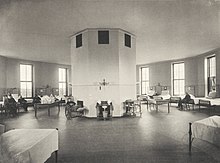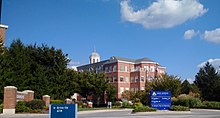A trauma center, or trauma centre, is a hospital equipped and staffed to provide care for patients suffering from major traumatic injuries such as falls, motor vehicle collisions, or gunshot wounds. A trauma center may also refer to an emergency department without the presence of specialized services to care for victims of major trauma.

Stanford University Medical Center is a medical complex which includes Stanford Health Care and Stanford Children's Health. It is consistently ranked as one of the best hospitals in the United States and serves as a teaching hospital for the Stanford University School of Medicine. In 2022–23, it was ranked by the US News as the 3rd-best hospital in California and 10th-best in the country.
The NewYork-Presbyterian Hospital, a nonprofit academic medical center in New York City, is the primary teaching hospital for two Ivy League medical schools, Weill Cornell Medicine at Cornell University and Columbia University Vagelos College of Physicians and Surgeons at Columbia University. The hospital includes seven campuses located throughout the New York metropolitan area. The hospital's two flagship medical centers, Columbia University Irving Medical Center and Weill Cornell Medical Center, are located on opposite side of Upper Manhattan.
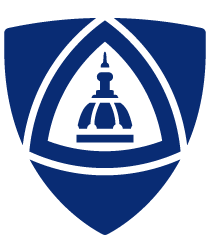
The Johns Hopkins University School of Medicine (JHUSOM) is the medical school of Johns Hopkins University, a private research university in Baltimore, Maryland. Founded in 1893, the School of Medicine shares a campus with Johns Hopkins Hospital and Johns Hopkins Children's Center, established in 1889.

William Stewart Halsted, M.D. was an American surgeon who emphasized strict aseptic technique during surgical procedures, was an early champion of newly discovered anesthetics, and introduced several new operations, including the radical mastectomy for breast cancer. Along with William Osler, Howard Atwood Kelly and William H. Welch, Halsted was one of the "Big Four" founding professors at the Johns Hopkins Hospital. His operating room at Johns Hopkins Hospital is in Ward G, and was described as a small room where medical discoveries and miracles took place. According to an intern who once worked in Halsted's operating room, Halsted had unique techniques, operated on the patients with great confidence and often had perfect results which astonished the interns.

University of Iowa Hospitals & Clinics (UIHC) is an 811-bed public teaching hospital and level 1 trauma center affiliated with the University of Iowa. UI Hospitals and Clinics is part of University of Iowa Health Care, a partnership that includes the University of Iowa Roy J. and Lucille A. Carver College of Medicine and the University of Iowa Physicians group practice.

Adventist HealthCare Shady Grove Medical Center is a 266-licensed bed acute care facility located in Rockville, Maryland. Shady Grove Medical Center provides a range of health services to the community such as high-risk obstetrical care, cardiac and vascular care, oncology services, orthopedic care, surgical services and pediatric care. Opened in 1979 as Shady Grove Adventist Hospital, Shady Grove Medical Center operates as part of Adventist HealthCare, a health-care delivery system that includes hospitals, home health agencies and other health-care services. Adventist HealthCare is headquartered in Gaithersburg, Maryland.
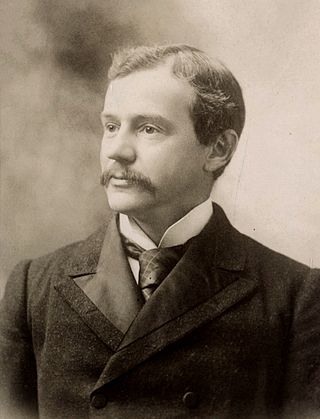
Howard Atwood Kelly was an American gynecologist. He obtained his B.A. degree and M.D. degree from the University of Pennsylvania. He, William Osler, William Halsted, and William Welch together are known as the "Big Four", the founding professors at the Johns Hopkins Hospital in Baltimore, Maryland. He is credited with establishing gynecology as a specialty by developing new surgical approaches to gynecological diseases and pathological research. He also developed several medical innovations, including the improved cystoscope, Kelly's clamp, Kelly's speculum, and Kelly's forceps. Because Kelly was a famous prohibitionist and Fundamentalist Christian, many of his contemporaries expressed skepticism towards his medical professionalism.

Greater Baltimore Medical Center (GBMC) is a U.S. hospital located in the Baltimore suburb of Towson, Maryland. It was opened in 1965. GBMC serves more than 20,455 inpatient cases and approximately 52,000 emergency department visits annually. GBMC's main campus includes three medical office buildings—Physicians Pavilion East, Physicians Pavilion West and Physicians Pavilion North I. In addition to its main campus located in Towson, GBMC has several facilities located throughout the community including Hereford, Hunt Manor, Hunt Valley, Owings Mills, Perry Hall, Lutherville, Phoenix and Timonium.

University of Missouri Health Care is an American academic health system located in Columbia, Missouri. It's owned by the University of Missouri System. University of Missouri Health System includes five hospitals: University Hospital, Ellis Fischel Cancer Center, Missouri Orthopedic Institute and University of Missouri Women's and Children's Hospital — all of which are located in Columbia. It's affiliated with Capital Region Medical Center in Jefferson City, Missouri. It also includes more than 60 primary and specialty-care clinics and the University Physicians medical group.
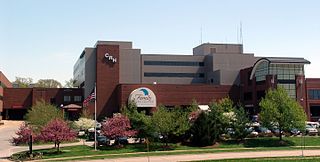
The University of Missouri Women's Hospital, formerly University of Missouri Women's Hospital, is the only hospital in Missouri exclusively dedicated to the health of women. The hospital was formerly home to MU Children's Hospital, and is currently home to MU Women's Center, and the Family Birth Center. The Women's Hospital no longer has a pediatric Emergency Room and inpatient services, having moved to University Hospital. In Fiscal Year 2009, 1,793 babies were born in the Family Birth Center. The hospital has the da Vinci minimally invasive surgical robotic system. It is located in eastern Columbia near the interchange of Interstate 70 and U.S. 63 at 404 North Keene Street.

Johns Hopkins All Children's Hospital, formerly All Children's Hospital, is a pediatric acute care children's hospital located in St. Petersburg, Florida. The hospital has 259 beds and is affiliated with the USF Morsani College of Medicine and Johns Hopkins University School of Medicine. The hospital provides comprehensive pediatric specialties and subspecialties to pediatric patients aged 0–21 throughout western Florida. Johns Hopkins All Children's Hospital also features a Level 2 Pediatric Trauma Center.
MedStar Health is a not-for-profit healthcare organization. It operates more than 120 entities, including ten hospitals in the Baltimore–Washington metropolitan area of the United States. In 2011 it was ranked as the employer with the largest number of local employees in the region.
St. Cloud Hospital is a hospital in St. Cloud, Minnesota, United States. It is a Catholic-affiliated, not-for-profit institution and part of CentraCare Health. The hospital has more than 9,000 employees, 400 physicians and 1,200 volunteers. It serves 690,000 people in a 12-county area.
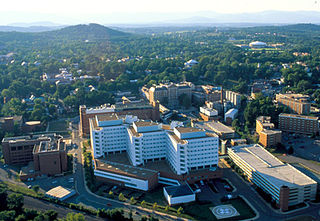
The University of Virginia (UVA) Health System is an academic health care center associated with the University of Virginia in Charlottesville. The health system includes a medical center, school of medicine, school of nursing, and health sciences library. The health system provides inpatient and outpatient care and patient education and conducts medical research and education.
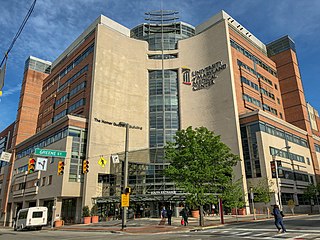
The University of Maryland Medical Center (UMMC) is a teaching hospital with 806 beds based in Baltimore, Maryland, that provides the full range of health care to people throughout Maryland and the Mid-Atlantic region. It gets more than 26,000 inpatient admissions and 284,000 outpatient visits each year. UMMC has approximately 9,050 employees at the UMMC Downtown Campus, as well as 1,300 attending physicians and 950 resident physicians across the Downtown and the Midtown campuses. UMMC provides training for about half of Maryland's physicians and other health care professionals. All members of the medical staff are on the faculty of the University of Maryland School of Medicine.

Mt. Washington Pediatric Hospital is a United States 102-bed non-profit children's hospital set in the scenic neighborhood of Mt. Washington in Baltimore, Maryland, that provides long-term care for children with complex health problems. MWPH is jointly owned by Johns Hopkins Medical System and University of Maryland Medical System. Funded by patient revenue and private charitable donations, Mt. Washington Pediatric Hospital is a comprehensive sub-acute care facility for children from birth to young adult; MWPH provides transitional and support care for a variety of conditions, including premature birth, serious and chronic illness, traumatic injury, ADHD, autism spectrum disorder, cerebral palsy, childhood obesity, diabetes, feeding problems, among others. Mt. Washington Pediatric Hospital also has a unit at Prince George's Hospital Center in Cheverly, Maryland. MWPH accreditations include Commission on Accreditation of Rehabilitation Facilities and The Joint Commission.
Medical centers in the United States are conglomerations of health care facilities including hospitals and research facilities that also either include or are closely affiliated with a medical school. Although the term medical center is sometimes loosely used to refer to any concentration of health care providers including local clinics and individual hospital buildings, the term academic medical center more specifically refers to larger facilities or groups of facilities that include a full spectrum of health services, medical education, and medical research.

The University of Florida College of Medicine – Jacksonville is the largest of the three University of Florida Health Science Center Jacksonville colleges — medicine, nursing and pharmacy. The college's 16 clinical science departments house more than 440 faculty members and 380 residents and fellows. The college offers 34 accredited graduate medical education programs and 10 non-standard programs.

Johns Hopkins Children's Center (JHCC) is a nationally ranked, pediatric acute care children's teaching hospital located in Baltimore, Maryland, United States, adjacent to Johns Hopkins Hospital. The hospital has 196 pediatric beds and is affiliated with the Johns Hopkins School of Medicine. The hospital is the flagship pediatric member of Johns Hopkins Medicine and is one of two children's hospitals in the network. The hospital provides comprehensive pediatric specialties and subspecialties to infants, children, teens, and young adults aged 0–21 throughout Baltimore and the wider United States. Johns Hopkins Children's Center also sometimes treats adults who require pediatric care. Johns Hopkins Children's Center also features the only ACS verified Level 1 Pediatric Trauma Center in the state. The hospital is directly attached to Johns Hopkins Hospital and is situated near the Ronald McDonald House of Maryland.





